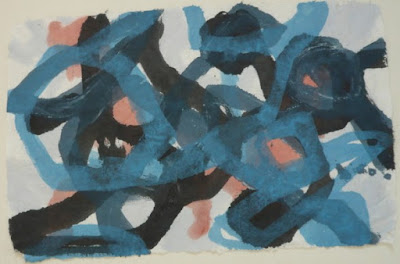 |
Judith Trepp, 2013, ink and acrylic on Indian handmade paper, 18.5 x 29 in.
|
Thich Nhat Hanh: "
Pratitya samutpada is sometimes called the teaching of cause and effect, but that can be misleading, because we usually think of cause and effect as separate entities, with cause always preceding effect, and one cause leading to one effect. According to the teaching of Interdependent Co-Arising, cause and effect co-arise (samutpada) and everything is a result of multiple causes and conditions... In the sutras, this image is given: "Three cut reeds can stand only by leaning on one another. If you take one away, the other two will fall." For a table to exist, we need wood, a carpenter, time, skillfulness, and many other causes. And each of these causes needs other causes to be. The wood needs the forest, the sunshine, the rain, and so on. The carpenter needs his parents, breakfast, fresh air, and so on. And each of those things, in turn, has to be brought about by other causes and conditions. If we continue to look in this way, we'll see that nothing has been left out. Everything in the cosmos has come together to bring us this table. Looking deeply at the sunshine, the leaves of the tree, and the clouds, we can see the table. The one can be seen in the all, and the all can be seen in the one. One cause is never enough to bring about an effect. A cause must, at the same time, be an effect, and every effect must also be the cause of something else. Cause and effect inter-are. The idea of first and only cause, something that does not itself need a cause, cannot be applied."


Comments
Post a Comment